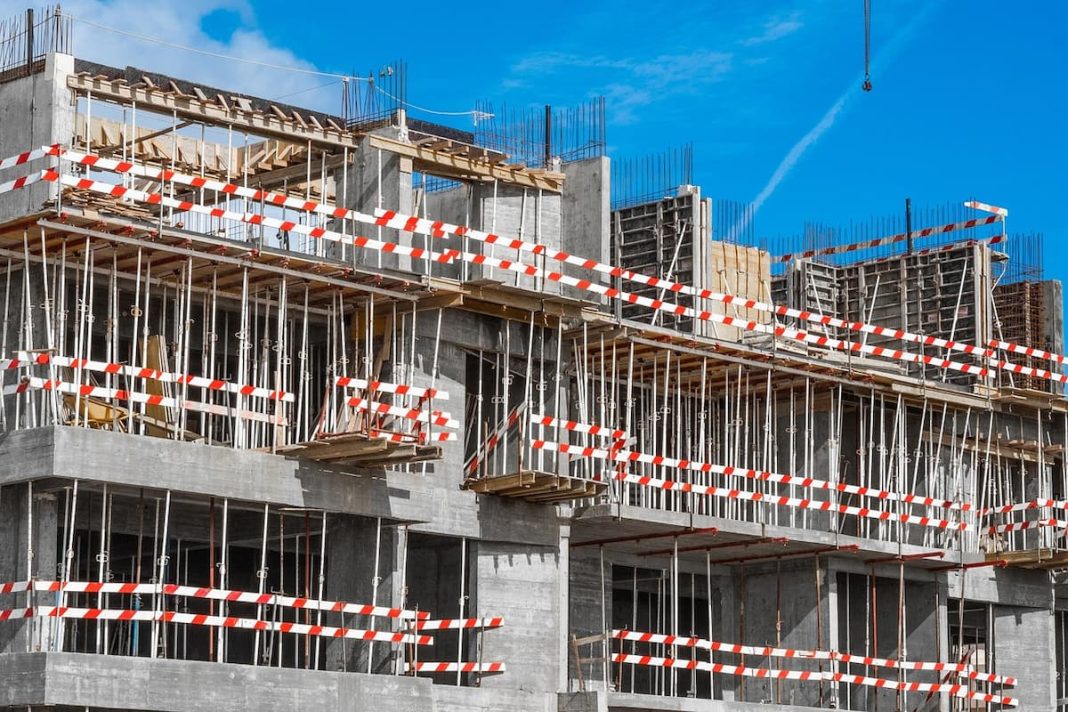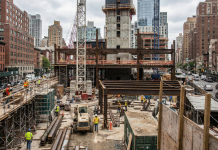In today’s construction US news, read about how the annual rate of privately owned homes starts in July at 1,428,000, adjusted for seasonal factors. On the other hand, despite builders’ persistent challenges with rising prices, labor shortages, and recent market headwinds, there was an unexpected boost in construction activity for single-family houses across the country last month, driven by outlying areas. Lastly, North American lumber production totaled 24.032 billion board feet through May, which was down 2.8%, or 685 million board feet, from the same period a year ago, according to the Western Wood Products Association’s Lumber Track publication.
July 2025 Monthly Residential Construction
Original Source: MONTHLY NEW RESIDENTIAL CONSTRUCTION, JULY 2025
Building Permits
The seasonally adjusted annual rate of privately owned dwelling units authorized by building permits in July was 1,354,000. This is 2.8 percent below June’s revised pace of 1,393,000 and 5.7 percent below July 2024’s 1,436,000. July single-family authorizations were 870,000, up 0.5% from June’s revised 866,000. July saw 430,000 unit authorizations in five-unit complexes.
Housing Starts
July private-owned home starts were 1,428,000 seasonally adjusted. This is 5.2 percent (±14.7 percent)* higher than the revised June estimate of 1,358,000 and 12.9 percent (±13.6 percent) higher than July 2024’s rate of 1,265,000 In July, single-family home starts reached 939,000, a 2.8 percent (±11.8%) increase from the revised June number of 913,000. Units in five-unit complexes cost 470,000 in July.
Housing Completed
July private-owned housing completions were 1,415,000 seasonally adjusted. This is 6.0 percent (±13.5 percent)* higher than the revised June estimate of 1,335,000, but 13.5 percent (±10.8 percent) lower than the July 2024 rate of 1,635,000 In July, single-family dwelling completions reached 1,022,000, up 11.6 percent (±14.6 percent)* from the revised June rate of 916,000. For structures with five or more units, July rates were 385,000.
Map Illustrates Increase in Home Construction in Southern U.S. States
Original Source: Map Shows Home Construction Boost in US Southern States
Last month, southern states boosted single-family house production nationwide despite builders’ challenges with rising prices, labor shortages, and market headwinds.
The US Census Bureau and HUD reported 939,000 seasonally adjusted single-family home starts in July, up 2.8 percent from June. In the next year, builders would start building this many single-family homes.
Overall, single-family house construction activity is down, but the South had a significantly bigger increase. Single-family starts increased 13% month-over-month and 22% year-over-year in the region.
Monthly and annual single-family housing starts declined in the Midwest, Northeast, and West.
What Do These Numbers Say About the U.S. Housing Market?
The spike in single-family house starts surprised experts watching the U.S. housing market, where a recent inventory surge has forced developers to offer price cuts and other incentives to lure reluctant customers and sell their completed homes.
After evidence of a worsening U.S. labor market, mortgage rates fell slightly, which may explain this recent surge. In the week ending August 14, the 30-year fixed-rate mortgage, the most popular home loan among Americans, averaged 6.58 percent, the lowest level since October 2024.
Southern dominance may be due to its recent development boom, which has outpaced the Midwest, Northeast, and West.
In recent years, Florida and Texas have built more new homes than any other state, but they have recently substantially reduced development due to an inflow of new listings, many of which are taking longer to go under contract.
Thus, academics and industry insiders are cautious about applauding the surprise rise in single-family housing starts. Newsweek quoted Redfin head economist Daryl Fairweather as saying the surge “is an aberration.”
“This series has always been boisterous. The U.S. Census Bureau’s news statement specifies a 27.4% ± 39.3% error margin for the year-over-year change, indicating a growth rate range of 11.9 to +66.7 percent.
“All things considered, this month’s new construction data does not provide many clear signals as to where homebuilding is heading,” Realtor.com senior economist Joel Berner reported. “We know that new home sales have been quite slow this summer and that tariffs are adding complication and expense to building activity, but builders do not appear to be backing down much more than they already have.”
Homebuilders Say?
Despite the recent surge in single-family dwelling starts, builders remain gloomy about housing building.
“Single-family production continues to operate at reduced levels due to ongoing housing affordability challenges, including persistently high mortgage rates, the skilled labor shortage and excessive regulatory costs,” said NAHB chairman Buddy Hughes in a press release.
“These headwinds were reflected in our latest builder survey, which indicates that affordability is the top housing market challenge,” said Lexington, North Carolina home builder and developer Hughes.
Builder confidence in the market for newly built single-family homes dropped 1 point to 32 in August, according to the NAHB survey. Builders are unhappy with the market if their score is below 50.
“The slowdown in single-family home building has narrowed the pipeline,” said NAHB chief economist Robert Dietz. “621,000 single-family homes are under construction, down 1% in July and 3.7 % a year earlier. This is the lowest level since early 2021 as builders reduce supply.”
Construction and Lumber Prices Fluctuated Amid Economic Changes
Original Source: US housing market analysis: Construction market and lumber prices mixed amid economic shifts
June housing starts rose due to strong multifamily development, but single-family construction plummeted to its lowest level in a year.
Canadians will pay 35.19% in countervailing and anti-dumping taxes after the yearly CVD review.
Builder confidence remains low due to high mortgage rates, low buyer activity, and supply-side issues.
May North American lumber production down 2.8% from 2024.
Changes in housing starts in recent months?
Housing starts rose in June, but multifamily development drove it.
The US Census Bureau reported 1.321 million home starts, up 4.6% from May’s upwardly revised 1.263 million. The headline statistic again hid different trends between the two categories.
Single-family housing starts dipped 4.6% to 883,000 units, the lowest in almost a year, while multifamily starts soared 30% to 438,000. The previous two months were improved, with May and June seeing 52,000 more units.
In June, building permits, a sign of future construction, stayed at 1.397 million. June apartment development in the Northeast rose 73% over May, the only positive boost.
How have Canadian duties changed?
After the sixth annual CVD evaluation by the US Department of Commerce was released today, Canadians will pay 35.19% in countervailing and anti-dumping taxes starting this month.
Commerce examined West Fraser and Canfor separately and found 16.82% and 12.12% CVD rates. All other Canadian shippers will pay 14.63%, the weighted average of the two inspected businesses. After publication in the Federal Register next week, the new CVD rate will take effect. Canadians pay 6.74% for CVD.
Interest in US housing market developments? Our lumber market commentary covers US housing market trends and dynamics. Try our lumber market commentary for free today.
Commerce raised the final anti-dumping duty rate to 20.56% from 7.66% two weeks previously. Thus, Canadians will pay 35.19% in AD/CVD charges on U.S. shipments, up from 14.40%.
Canfor will have 47.65% AD/CVD and West Fraser 26.47%.
What affects US builder confidence?
In August, high mortgage rates, limited buyer traffic, and supply-side issues kept builder confidence in a holding pattern.
The NAHB/Wells Fargo Housing Market Index (HMI) showed builder confidence in the market for newly built single-family homes at 32 in August, down one point from July. Builder sentiment has been negative for 16 months and between 32 and 34 since May.
Buyers are waiting for mortgage rates to reduce to move forward because affordability remains the biggest property market issue. Builders also face supply-side challenges, such as regulatory issues related to land development and homebuilding.
Lexington, N.C. house builder and developer Buddy Hughes is NAHB Chairman.
The latest in North American lumber production?
North American lumber production was 24.032 billion board feet through May, down 2.8%, or 685 million board feet, from a year earlier, according to the Western Wood Products Association’s Lumber Track newsletter.
Through May, US lumber production was 15.579 bbf, down 0.4% from 2024. South production rose 0.6%, while West production fell 2.1%. Through May, Canada produced 8.453 bbf of lumber, down 6.9% from the previous year. British Columbia production fell 8.2% and East of the Rockies 6.3%.
Which lumber market trends are current?
The Section 232 probe into wood product imports may be raising market prices’ risk premium. Demand is weak—apparent consumption is down 3% year-to-date. March’s modest import increases were swiftly absorbed, and supply cuts were minimal.
US housing market: what next?
High economic uncertainties and tariffs make construction forecasts bleak. The construction industry is extremely vulnerable to tariffs, and the US effective tariff rate is above 16%, the highest since the 1930s. Material price increases make building projects more expensive, especially for smaller, regional homebuilders with thinner margins.
Navigating the US wood products market requires understanding the complex interplay between timber prices, house development trends, and inflation. Ask one of our specialists about Fastmarkets’ latest industry insights and price data.
Summary of today’s construction news
In summary, the revised June rate was 916,000, while the single-family dwelling completions in July were 1,022,000, an increase of 11.6 percent. For buildings with five units or more, the rate for July was 385,000 square feet.
On the other hand, monthly and yearly starts for single-family homes actually declined in the West, Northeast, and Midwest. The recent building boom in the South, which has been unmatched in the Midwest, Northeast, and West, may be a contributing factor to the fact that the South is driving the surge alone.
Lastly, May 2024 had a 2.8% decline in North American lumber production compared to May 2025. With a decrease of 0.4% over the first five months of 2024, US lumber production reached 15.579 bbf through May.








